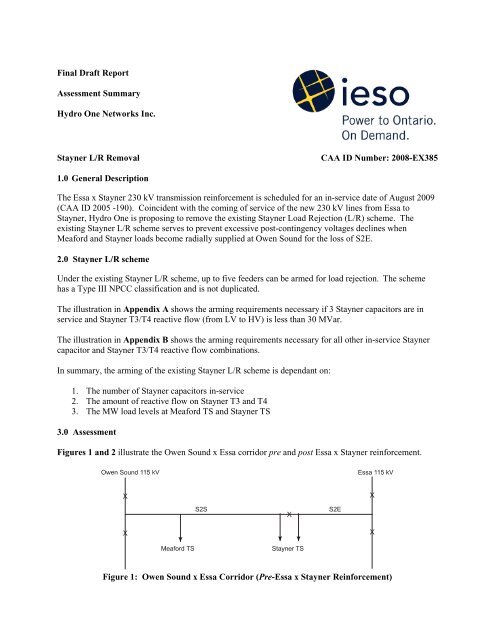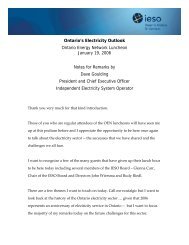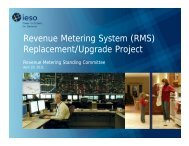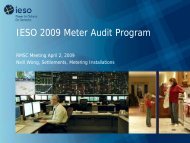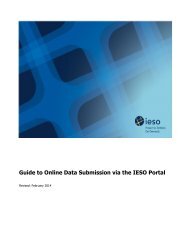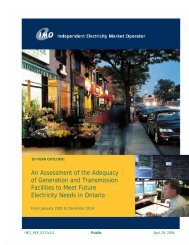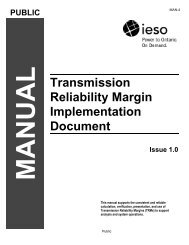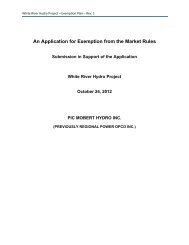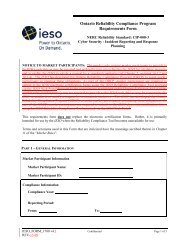Final Draft Report - IESO
Final Draft Report - IESO
Final Draft Report - IESO
Create successful ePaper yourself
Turn your PDF publications into a flip-book with our unique Google optimized e-Paper software.
<strong>Final</strong> <strong>Draft</strong> <strong>Report</strong>Assessment SummaryHydro One Networks Inc.Stayner L/R RemovalCAA ID Number: 2008-EX3851.0 General DescriptionThe Essa x Stayner 230 kV transmission reinforcement is scheduled for an in-service date of August 2009(CAA ID 2005 -190). Coincident with the coming of service of the new 230 kV lines from Essa toStayner, Hydro One is proposing to remove the existing Stayner Load Rejection (L/R) scheme. Theexisting Stayner L/R scheme serves to prevent excessive post-contingency voltages declines whenMeaford and Stayner loads become radially supplied at Owen Sound for the loss of S2E.2.0 Stayner L/R schemeUnder the existing Stayner L/R scheme, up to five feeders can be armed for load rejection. The schemehas a Type III NPCC classification and is not duplicated.The illustration in Appendix A shows the arming requirements necessary if 3 Stayner capacitors are inservice and Stayner T3/T4 reactive flow (from LV to HV) is less than 30 MVar.The illustration in Appendix B shows the arming requirements necessary for all other in-service Staynercapacitor and Stayner T3/T4 reactive flow combinations.In summary, the arming of the existing Stayner L/R scheme is dependant on:1. The number of Stayner capacitors in-service2. The amount of reactive flow on Stayner T3 and T43. The MW load levels at Meaford TS and Stayner TS3.0 AssessmentFigures 1 and 2 illustrate the Owen Sound x Essa corridor pre and post Essa x Stayner reinforcement.Figure 1: Owen Sound x Essa Corridor (Pre-Essa x Stayner Reinforcement)
Figure 2: Owen Sound x Essa Corridor (Post-Essa x Stayner Reinforcement)3.1 Removal of Existing SPSAs S2E will be retired along with the Essa x Stayner reinforcement, the existing Stayner L/R whichinitiates for the loss of S2E (contingency-based) will be inoperable and will need to be retired.3.2 Radial Load Supply at Owen Sound Post Essa x Stayner Reinforcement(1) All Elements in-serviceWith all elements in-service, there is no recognized contingency that would result in both Stayner andMeaford loads radial on to Owen Sound under a post- Essa x Stayner reinforcement configuration.The loss of E21S+E20S will separate Stayner TS from the 230 kV system, but will also result in the lossof Stayner load by configuration. Meaford load would become radially supplied by Owen Sound postcontingency.It can be proven that this radial Meaford load supplied by Owen Sound post-contingency is notdetrimental to the <strong>IESO</strong>-controlled grid. Under the existing Stayner L/R scheme, the load level atMeaford is accounted for by the MW quantity S2S Flow @ Owen Sound + S2E Flow @ Essa. Thisquantity represents the amount of load at Meaford TS and Stayner TS that would be supplied radially byOwen Sound in the event that S2E is lost.Arming is done (i) if this quantity exceeds 135 MW for the case when 3 Stayner capacitors are in-serviceand the reactive flow at Stayner T3 +T4 is less than 30 MVar (Appendix A), or (ii) if this quantityexceeds 150 MW in all other cases (Appendix B).The following table shows the Meaford summer and winter station capabilities obtained from the HydroOne Secure Operations Website.Meaford TS Summer and Winter Station CapabilitiesMeaford Station Capability(10 Day LTR of one transformer)WinterSummer60.8 MVA 53.9 MVA
As long as the existing station capabilities are respected, Meaford load will never become radiallysupplied at load levels greater than 135 MW or 150 MW. Therefore, for all elements in-service, radialload on Owen Sound 115 kV post Essa x Stayner reinforcement should not have a negative impact to the<strong>IESO</strong>-controlled grid.(2) Single Element out-of-serviceWith one element out of service, there may be several instances in which both Meaford and Stayner loadbecome radially supplied by Owen Sound.For an outage to the inline breaker at E21S or the circuit E20S, Meaford and Stayner loads may becomeradially supplied by Owen Sound for the loss of E20S or inadvertent operation of the E21S breakerrespectively.It is recommended that for these conditions, pre-contingency measures such as opening the Stayner 115kV breaker can be considered. For the above mentioned contingencies, this would result in the rejectionof Stayner load by configuration.All rejected load must be restored within time frames outlined in the Load Restoration Criteria as per the<strong>IESO</strong> Transmission Assessment Criteria. More stringent restoration times are required for load in excessof 150 MW and 250 MW.The load forecast provided by Hydro One documented in the Essa x Stayner reinforcement SIA (CAA ID2005-190) does not project Stayner load to reach 150 MW in the next 6 years. However, in the future,when the load projection is expected to exceed this threshold, the use of any pre-contingency controlaction may need to be re-assessed if the amount of load rejected cannot be timely restored within criteria.4.0 Conclusions(1) The retirement of the existing Stayner L/R scheme will not have a material adverse effect on the<strong>IESO</strong>-controlled grid provided it is executed in conjunction with the retirement of S2E and the Essa xStayner reinforcement.(2) Coincident with Essa x Stayner reinforcement, a new L/R scheme is not required to address postcontingencyradial load supplied at Owen Sound.(3) With one element out of service, Meaford and Stayner loads may become radially supplied by OwenSound in post contingency.Pre-contingency control actions are available to reject Stayner load by configuration postcontingency.All rejected load must be restored within time frames outlined in the Load RestorationCriteria as per the <strong>IESO</strong> Transmission Criteria.If the ability to meet time frames outlined in the Load Restoration Criteria becomes a challenge due togrowing load, the use of pre-control actions may need to be re-assessed and alternative control actionsmay need to be investigated.5.0 Requirements(1) Deregistration of the Stayner L/R scheme will need to be completed during the Facility Deregistrationprocess
(2) Hydro One must notify the <strong>IESO</strong> as soon as it becomes aware of any changes to the assumptionsmade in the connection assessment. The <strong>IESO</strong> will determine whether these changes require areassessment and new requirements before connection.6.0 Notification of ApprovalThis expedited System Impact Assessment concludes that the removal of the Stayner Load RejectionScheme coincident with the Essa x Stayner reinforcement is not expected to have a material adverse effecton the <strong>IESO</strong>-controlled grid. It is therefore recommended that a Notification of Conditional Approval ofthe Proposal be issued, subject to the requirements detailed above.


